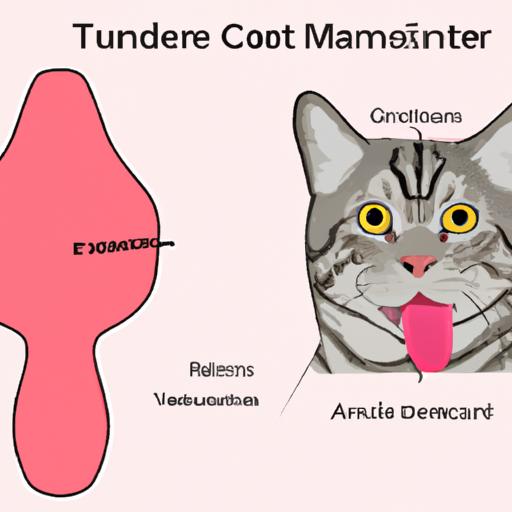Cat Tumor Under Tongue: Detecting Early for Optimal Treatment
It’s a heartwarming sight to see our furry feline companions purring contentedly and playfully batting at toys. But what if you notice something unusual, like a lump or swelling under your cat’s tongue? Don’t panic just yet, as it could be a cat tumor under the tongue. In this article, we’ll explore the significance of these tumors and emphasize the importance of early detection and treatment.
As responsible pet owners, we strive to ensure the well-being of our beloved cats. Understanding the nature of cat tumors under the tongue is crucial in offering them the care they need. These tumors, also known as sublingual masses, can arise from various origins, including benign or malignant growths. They can be challenging to detect at first, as cats are remarkably stoic creatures who often hide their discomfort. However, being vigilant and observant of any changes in their behavior or physical appearance is crucial.
Early detection of cat tumors under the tongue holds immense value in ensuring the best possible outcome for our feline friends. Detecting these tumors promptly allows for timely intervention and appropriate treatment, increasing the chances of successful management. By addressing the issue early on, we can potentially prevent the tumor from spreading to surrounding tissues or metastasizing to other parts of the body.
Remember, you are your cat’s advocate and guardian. Regularly examining their mouth, especially under the tongue, can help you detect any abnormalities early on. If you notice any swelling, lumps, or changes in your cat’s eating habits or behavior, it’s essential to seek veterinary care promptly. Your veterinarian will perform the necessary diagnostic procedures to identify the type of tumor and recommend appropriate treatment options.
Stay tuned for the following sections, where we will delve deeper into understanding cat tumors under the tongue, their potential causes, risk factors, and the available treatment options. Together, let’s ensure the well-being of our feline companions by being proactive and knowledgeable about their health.
Understanding Cat Tumors under the Tongue
Definition and Types of Tumors
When it comes to cat tumors under the tongue, it’s important to understand the different types that can develop. These tumors can originate from various sources, including both benign and malignant growths. Benign tumors, such as fibromas or papillomas, are non-cancerous and typically have a slow growth rate. Malignant tumors, on the other hand, can be more aggressive and may include squamous cell carcinoma or melanoma.
Common Symptoms and Signs to Look For
Detecting cat tumors under the tongue can be challenging, as these areas are not easily visible during routine examinations. However, there are certain signs and symptoms that can indicate the presence of a tumor. Keep an eye out for the following:
-
Difficulty Eating: Cats with tumors under their tongue may experience difficulties while eating or show a decreased appetite. They may exhibit discomfort or pain while chewing or swallowing their food.
-
Excessive Drooling: Excessive drooling, also known as hypersalivation, can be a sign of an underlying issue, including cat tumors under the tongue. Pay attention if you notice a sudden increase in drooling without any apparent cause.
-
Unusual Swelling or Lumps: Observe your cat’s mouth carefully. If you notice any abnormal swelling or lumps under the tongue, it’s crucial to have them examined by a veterinarian.
-
Halitosis (Bad Breath): Persistent bad breath that doesn’t improve with dental hygiene measures can be an indication of an underlying problem, including tumors under the tongue.
-
Changes in Behavior: Cats may exhibit changes in behavior when they are in pain or discomfort. If you notice your cat acting differently, such as being more irritable, withdrawn, or avoiding certain foods, it’s essential to consider the possibility of a tumor under the tongue.
Remember, these symptoms may not necessarily indicate the presence of a tumor, but they should raise concern and prompt a visit to the vet for a thorough examination. Early detection and intervention are key to ensuring the best possible outcome for your feline friend.
Causes and Risk Factors
When it comes to understanding the causes of cat tumors under the tongue, veterinarians are still unraveling the complexities of this condition. While the exact origins of these tumors remain uncertain, several possible causes have been identified.
Possible Causes of Cat Tumors under the Tongue
-
Genetic Predisposition: Some studies suggest that certain cat breeds may have a higher susceptibility to developing tumors under the tongue. While further research is needed to establish a definitive link, it’s important to be aware of any breed-specific risks.
-
Oral Infections or Inflammation: Chronic oral infections or inflammations can potentially contribute to the development of tumors. Poor oral hygiene and untreated dental issues may create an environment that fosters tumor growth.
-
Environmental Factors: Exposure to certain environmental factors, such as tobacco smoke or certain chemicals, may increase the risk of developing tumors under the tongue. Minimizing exposure to these substances can help mitigate the risk.
Factors that May Increase a Cat’s Risk
-
Age: While tumors under the tongue can affect cats of any age, they are more commonly observed in older felines. Aging cats may have a higher risk due to cumulative effects of genetic predisposition, environmental factors, and overall health.
-
Diet and Obesity: Unhealthy dietary habits and obesity can impact a cat’s immune system and overall health, potentially increasing the risk of tumor development. Providing a balanced diet and maintaining a healthy weight can help reduce this risk.
-
Oral Care: Neglecting oral hygiene can lead to oral health issues, including inflammation and infections. Regular dental care, including brushing and professional cleanings, can help prevent the development of tumors under the tongue.
Remember, these potential causes and risk factors are not definitive and may vary from cat to cat. It’s crucial to consult with your veterinarian to assess your cat’s individual risk profile and take appropriate preventive measures. In the next section, we will explore the diagnostic procedures used to identify cat tumors under the tongue and the importance of seeking veterinary care for proper diagnosis and treatment.
Diagnosis and Veterinary Care
Diagnostic Procedures for Identifying Cat Tumors under the Tongue
When it comes to diagnosing cat tumors under the tongue, veterinarians employ various diagnostic procedures to accurately identify the presence and nature of the tumor. These procedures provide essential information that guides the subsequent treatment plan. Here are some commonly used diagnostic methods:
-
Physical Examination: During a physical examination, your veterinarian will carefully assess your cat’s oral cavity, including the area under the tongue. They will palpate for any lumps, swelling, or abnormalities and observe any changes in your cat’s behavior or eating habits.
-
Biopsy: A biopsy involves the collection of a small tissue sample from the tumor. This sample is then sent to a laboratory for analysis. The biopsy helps determine whether the tumor is benign or malignant, providing crucial information for treatment decisions.
-
Imaging Techniques: Imaging techniques such as X-rays, ultrasounds, or CT scans may be utilized to assess the extent of the tumor and identify any potential spread to nearby structures or lymph nodes. These imaging modalities aid in developing a comprehensive treatment plan.
Importance of Seeking Veterinary Care for Proper Diagnosis and Treatment
Prompt veterinary care is essential when dealing with cat tumors under the tongue. Seeking professional guidance ensures an accurate diagnosis and appropriate treatment, increasing the chances of a successful outcome. Here’s why it’s crucial to consult a veterinarian:
-
Expertise and Experience: Veterinarians possess the necessary knowledge and expertise to identify and diagnose cat tumors under the tongue accurately. They have extensive experience in assessing the severity of the condition and tailoring the treatment plan accordingly.
-
Specialized Equipment and Techniques: Veterinary clinics are equipped with specialized equipment and diagnostic tools that aid in the identification and evaluation of tumors under the tongue. These resources allow for a thorough assessment, leading to a more precise diagnosis.
-
Tailored Treatment Plans: Each case is unique, and a veterinarian will devise a treatment plan specific to your cat’s condition. This individualized approach takes into account factors such as the tumor’s characteristics, your cat’s overall health, and your preferences as a pet owner.
Remember, early detection and prompt veterinary care are crucial for the best possible outcome. By entrusting your cat’s care to a veterinarian, you ensure that they receive the necessary attention and treatment required to combat cat tumors under the tongue effectively.
In the upcoming sections, we will explore the various treatment options available for managing these tumors and discuss the prognosis and aftercare involved. Stay tuned to empower yourself with knowledge and make informed decisions for your feline companion’s well-being.
Treatment Options
When it comes to addressing cat tumors under the tongue, various treatment options exist to combat these growths and provide relief for our feline companions. The choice of treatment depends on several factors, including the type of tumor, its size, and the overall health of the cat. Let’s explore the different treatment options available and discuss their potential benefits.
Surgical Interventions
Surgery is often a primary treatment modality for cat tumors under the tongue. The aim of surgical intervention is to remove the tumor completely, along with any affected surrounding tissues. This procedure may involve excision of the tumor alone or, in more severe cases, the removal of a portion of the tongue. While the latter may affect the cat’s ability to eat or groom, it is crucial for preventing the tumor from spreading.
Chemotherapy
In cases where the tumor is malignant or has spread to other parts of the body, chemotherapy may be recommended. Chemotherapy involves the administration of anti-cancer medications to target and destroy cancer cells. This systemic treatment can help shrink tumors, prevent their growth, and alleviate symptoms. Although it may have side effects such as nausea or hair loss, chemotherapy can significantly improve the chances of remission and prolong the cat’s quality of life.
Radiation Therapy
Radiation therapy, another treatment modality for cat tumors under the tongue, utilizes targeted radiation to destroy cancer cells. This localized treatment is typically delivered over several sessions, aiming to shrink the tumor and prevent its further growth. Radiation therapy is often used in conjunction with surgery or chemotherapy to maximize effectiveness. While there may be some side effects such as temporary irritation or hair loss in the treated area, radiation therapy can be highly beneficial in achieving favorable outcomes.
By combining different treatment approaches, such as surgery, chemotherapy, and radiation therapy, veterinarians can tailor a comprehensive treatment plan to suit each cat’s unique condition. The choice of treatment depends on factors like the tumor type, stage, and overall health of the cat. It’s crucial to consult with your veterinarian to determine the most suitable treatment options for your feline companion.
In the subsequent section, we will explore the prognosis and aftercare considerations for cats undergoing treatment for tumors under the tongue. Stay tuned to learn more about the journey towards recovery and the steps we can take to ensure our cats receive the best possible care.
Conclusion
In conclusion, cat tumors under the tongue are a concerning health issue that requires our attention as responsible pet owners. Early detection and prompt treatment play a pivotal role in ensuring the best possible outcome for our furry companions.
By understanding the significance of cat tumors under the tongue, we can be proactive in monitoring our cats’ oral health. Regular check-ups and vigilant observation of any changes in behavior or physical appearance can help us detect any abnormalities early on.
Remember, our cats rely on us to be their advocates. If you notice any swelling, lumps, or changes in eating habits, don’t hesitate to seek veterinary care. Timely intervention and appropriate treatment can make a significant difference in managing these tumors and preventing further complications.
Through the diagnostic procedures performed by veterinarians, the type of tumor can be identified, leading to personalized treatment options. Surgical interventions, chemotherapy, radiation therapy, or a combination may be recommended based on the specific case.
Aftercare and regular follow-up appointments are crucial to monitor the progress and ensure the best possible prognosis. By working closely with your veterinarian, you can provide the necessary support and care to help your cat during their journey towards recovery.
Let’s prioritize the well-being of our feline friends and be proactive in our efforts to detect and manage cat tumors under the tongue. Together, we can give them the love, care, and attention they deserve, ensuring a happy and healthy life by their side.
Remember, your cat’s health is in your hands. Stay vigilant, stay informed, and let’s give our furry friends the best chance at a long and fulfilling life.





